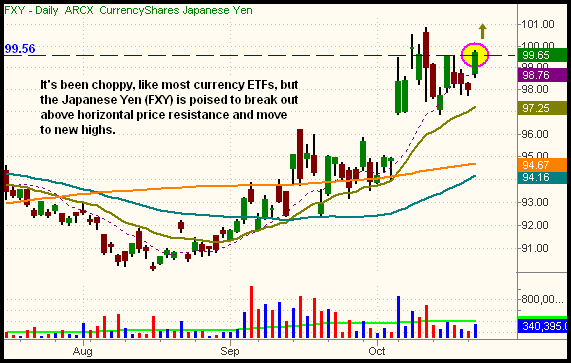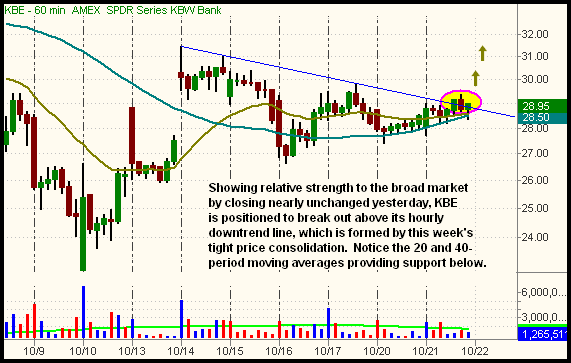|
The Wagner Daily ETF Report For October 22
A tug-of-war between the bulls and bears kept traders on their toes yesterday, but the bears grabbed the upper hand by the closing bell. After opening lower, the major indices immediately rallied to test their previous day's highs, declined several percent an hour later, reversed all the way back to test their morning highs just after mid-day, then fell to their intraday lows in the final hour of trading. The roller coaster session caused the Dow Jones Industrial Average to lose 2.5%, the S&P 500 3.1%, and the Nasdaq Composite 4.1%. The small-cap Russell 2000 dropped 3.0%, as the S&P Midcap 400 shed 2.8%. All the main stock market indexes finished near their lows of the day.
Total volume in the NYSE decreased 2% below the previous day's level, which is positive on a day of losses. Turnover in the Nasdaq, however, ticked 4% higher, causing the index to register a bearish "distribution day." Though it was the first display of institutional selling since the stock market's bullish reversal of October 16, it is negative to see a session of higher volume losses so soon after a high-volume reversal day. Market internals were obviously bearish, but not as extreme as we've become accustomed to seeing. In the NYSE, declining volume exceeded advancing volume by a margin of 4 to 1. The Nasdaq adv/dec volume ratio was negative by just over 6 to 1.
Last week, we sold our long position in CurrencyShares Japanese Yen (FXY) for a solid profit, after it began forming the right shoulder of a bearish "head and shoulders" pattern on its hourly chart. Since then, we've been monitoring its performance to see whether or not the pattern would follow through to the downside. Based on yesterday's price action, it now looks as though FXY is ready to make another leg higher, invalidating the "head and shoulders" pattern. Take a look at its daily chart below:

Annotated by the dashed, horizontal line, notice FXY is now poised to break out above a shelf of short-term horizontal price resistance at the $99.50 area. If it does, bullish momentum should send FXY to test resistance of its 52-week high of $103.46, set in March 2008. Although FXY is presently one of the strongest-looking ETF charts in the market, be aware that currency ETFs are notorious for large overnight gaps in both directions, caused by continuous trading of the FOREX markets. Be sure to give your stops enough "wiggle room" to account for these gaps. If buying FXY on the breakout above $99.50, consider a stop at least below the October 20 low of $97.77.
Yesterday, we said Energy and Basic Materials were two industry sectors that were starting to show relative strength to the major indices. Both sectors pulled back alongside of the broad market yesterday, but the pullback was moderate compared to the massive gains the sectors accumulated the previous day. In addition to those two industries, we also like the pattern the Bank Index ($BKX) is forming on its hourly chart. This is illustrated on the hourly chart of the SPDR Bank Index (KBE), a popular ETF proxy for the banking industry:

KBE (and the overall banking sector) demonstrated major relative strength to the main stock market indexes by closing nearly unchanged yesterday (down 7 cents). More importantly, KBE is about to break out above its hourly downtrend line, formed by the tight band of price consolidation over the past week. If KBE moves above the $30 level, it's worthy of a short-term buy entry. With this pattern, our buy entry would normally be just above yesterday's high of $29.36. However, since resistance of the 20-day exponential moving average is right at the $30 area, it may be better to wait for confirmation of a rally above that price before buying. Also, because resistance of the 50-day MA is at $32.22, this trade is probably best viewed as a short-term one. If buying KBE on the hourly chart breakout, consider a tight stop below yesterday's high, in order to protect against a failed breakout.
Because of the large decline in the broad market, it may seem as though yesterday's session was overly bearish. But keeping in context with the huge intraday price swings we've been seeing in recent weeks, the losses were not overly monstrous. In fact, yesterday was the S&P 500's tightest intraday trading range since October 1. Further, it was also an "inside day" for both the S&P 500 and Dow Jones Industrial Average. This means yesterday's intraday trading ranges of those two indexes were completely confined within their respective intraday ranges of the previous day. The Nasdaq nearly had an inside day as well, but closed just a couple points below the prior day's low. "Inside days" normally don't tell us much, other than stocks are in a holding pattern. We'll soon see what develops from the bullish consolidations forming on hourly charts of the major indices.
Deron Wagner is the Founder and Head Trader of both Morpheus Capital LP, a U.S. hedge fund, and Morpheus Trading Group, a trader education firm launched in 2001 that provides daily technical analysis of the leading ETFs and stocks. For a free trial to the full version of The Wagner Daily or to learn about Wagner's other services, visit MorpheusTrading.com or send an e-mail to deron@morpheustrading.com.
|